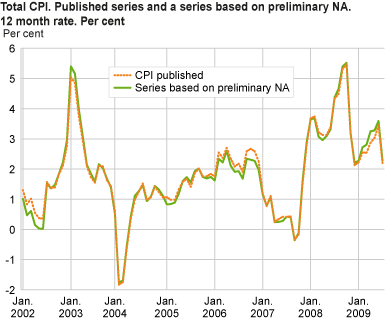CPI and HICP
CPI and HICP - New source for weighting
Published:
As from 2011, Statistics Norway will use the National Accounts (NA) as the primary weighting source. The NA data will be used in both the Consumer Price Index (CPI) and the Harmonized Consumer Price Index (HICP). NA will replace the Household Expenditure Survey (HES). As part of the amendments, December will be introduced as the price reference month in the CPI. This means that both indices will have the calendar year as the short-term chain link period. The January 2011 index, to be released on 10 February, will be the starting point for the new series. The index reference year (1998 = 100) will be continued.
This article provides a brief presentation of the main amendments introduced as part of the transition from the HES to the NA as the primary weighting source. It is based on an article (in Norwegian only) published last autumn. See Statistics Norway Economic Analyses, no. 4/2010 .
A new primary weighting source
Statistics Norway has, for some time, been discussing the quality of the primary weighting source used for the CPI and the HICP . Various initiatives to improve the HES quality in this context led to a decision to adopt the NA as a new primary source. Part of the decision basis was the ongoing process in Eurostat to devise a legal act recommending the National Accounts as the primary weighting source.
Some principal differences
Using NA as the primary weighting source entails changes in the weighting structures for both the CPI and the HICP when compared to the HES data. In general, changes are due to differences in measurement methods, in definitions and in principal differences in the coverage of the population.
HICP is designed to measure price changes covering resident and foreign households in Norway - according to a territorial principle. Based on the HES, this has not been possible, since consumption in foreign households has not been covered. CPI is based on a resident principle which includes resident consumption in Norway and abroad. The consumption abroad has not been covered by the HES. Furthermore, it should be noted that the use of NA also entails changes in the population of persons/households. Adopting the NA means full coverage of the population of all persons.
Residential buildings - consumption of goods and services
Household consumption of goods and services relating to residential buildings will change when NA is introduced as a source. The HES share is almost 29 per cent of the total, while NA data shows a share of almost 19 per cent. Differences in expenditures reflect different principals for the treatment of repair and maintenance. NA definitions - in line with SNA principles - define a large share of household expenditures as investments.
Insurance - financial services
Insurance services constitute a 2 per cent share of the total household consumption according to the NA. Life insurance is the largest single part of the group, which also includes insurance services related to transport vehicles, residential buildings and other buildings for household use. In line with the NA principles, the weighting shares for insurance in the CPI and HICP are measured according to a net principle - the sum of household payments excluding the repayments.
The weighting share of financial services increased from 0.1 per cent in 2010 according to the HES, to 3 per cent in 2011 using NA. The increase is mainly due to the inclusion of Financial Intermediation Services Indirectly Measured (FISIM). The FISIM-related consumption is not part of the HICP weighting base.
Some minor methodological adjustments
As from 2011, December will be the price reference month in the calculations of both the CPI and the HICP. This means that the short-term chain link period in both indices will be identical to the calendar year.
Also from 2011, the method for handling seasonal items will be adjusted in both indices. This adjustment is due to new Eurostat legislation concerning the treatment of seasonal items including clothing and footwear. The adjustments are likely to have some impact on product level but the aggregate effects are expected to be minor. No revisions will be made for previously published series in CPI or HICP.
NA preliminary version as the primary weighting source
The annual NA is produced in several versions. Analyses of the relevant versions concluded that the NA preliminary version should be favoured (t-2). This version satisfies the quality requirements in the index production process in relation to the timeliness, level of detail, availability etc. of data. Furthermore, the preliminary version provides the most up-to-date information on the product level composition in household consumption.
A retrospective analysis of the CPI covering the period 2001-2009 (test analyses) has formed part of the decision basis. The CPI total index previously published and the total index from the test analyses show no substantial deviations over the test period.
Differences are also minimal when comparing growth rates for the main groups (COICOP 2-digit). On more detailed levels, somewhat larger changes can be found. There are however no systematic deviations over the test period. Analyses of analytical series of CPI, i.e. index grouped according to the delivery sector, show the same growth pattern as previously published.
References:
ILO (2004): Consumer Price Index Manual: Theory and Practice, International Labour Organization, Genève.
Johannessen R. og Langer T. (2010): ” Nytt i konsumprisindeksen. Nasjonalregnskap - ny vektkilde ”, Økonomiske analyser 4/2010, Statistisk sentralbyrå.
Contact
-
Statistics Norway's Information Centre

